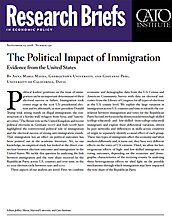Political leaders’ positions on the issue of immigration can be an important determinant of their electoral success or failure. Immigration took center stage in the 2016 U.S. presidential election and its aftermath, as now-president Donald Trump took strong stands on illegal immigration, the construction of a border wall, refugees from Syria, and “sanctuary cities.” The Brexit vote in the United Kingdom and recent political elections in Germany (2017) and Italy (2018) have highlighted the controversial political role of immigration and the electoral success of strong anti-immigration stands. That immigration has an effect on political outcomes has been pointed out in the academic literature. Yet, to our knowledge, no empirical study has looked at the direct connection between election outcomes and immigration in the United States. We tackle this question by analyzing the link between immigration and the vote share received by the Republican Party, across U.S. counties and over time, in the 20-year election cycle between 1990 and 2010.
Related Study
Deregulating Legal Immigration: A Blueprint for Agency Action
President Trump went to unprecedented lengths to restrict legal immigration in his one term—but the system was overly burdensome and expensive long before him. President-elect Joe Biden will have the opportunity to reverse these actions and deregulate this system. Here is a compendium of 30 proposals by 15 authors—including several of America’s leading immigration law experts—to help the Biden administration operate the immigration system as openly and efficiently as the law allows.
Three aspects of our analysis are novel. First, we combine economic and demographic data from the U.S. Census and American Community Survey with data on electoral outcomes from the Library of Congress for all types of elections at the U.S. county level. We exploit the large variation in immigration across U.S. counties and time to identify the correlation between immigration and votes for the Republican Party. Second, we focus on the distinction between high-skilled (college-educated) and low-skilled (non-college-educated) immigrants and exploit their differential variation, driven by past networks and differences in skills across countries of origin to separately identify a causal effect of each group. These two types of immigrants affect the economy and labor markets differently and, it turns out, they have very different effects on the votes of U.S. citizens. Third, we allow for heterogeneous effects of high- and low-skilled immigrants on voting outcomes, depending on the economic and demographic characteristics of the receiving county. In analyzing these heterogeneous effects we shed light on the possible mechanisms through which immigration may have impacted the vote share of the Republican Party.
The substantial inflow of immigrants to the United States during the last 30 years has significantly shaped the U.S. economy and society. Immigrants affect native workers’ opportunities in the labor market, their productivity, and their specialization. Immigrants can also have an impact on other aspects of the host country’s economy (for example, through fiscal effects, consumption, and contributions to scientific innovation), as well as on its culture, social norms, and sense of security. In addition, immigration can affect political outcomes. We analyze the latter outcomes but, in doing so, we also need to take into account the impact of immigration through the other channels. Indeed, we assume that, through their votes, U.S. citizens respond to the perceived economic and psychological costs and benefits—through the labor-market, fiscal, and noneconomic mechanisms— of having more immigrants in their county. We posit that their probability of voting for the Republican Party goes up if the perceived cost of an increase in immigrants (highskilled or low-skilled) is larger than the perceived benefit. In this simple framework we associate the Republican Party with more restrictive immigration policies, which it usually championed in the 20 years we consider. Immigration may also affect the outcome of elections by extending the pool of voters (i.e., directly) by adding the votes of newly naturalized immigrants. However, we find evidence suggesting that the main effect of immigrants on Republican votes comes from the indirect impact on preferences of existing voters.
Our strongest and most significant finding is that an increase in high-skilled immigrants as a share of the local population is associated with a strong and significant decrease in the vote share for the Republican Party. By contrast, an increase in the low-skilled immigrant share of the population is associated with a strong and significant increase in Republican votes. These effects are common to presidential and House and Senate elections. Combining the two effects, the net impact of the increased immigrant share on the average U.S. county was negative for the Republican Party between 1990 and 2010. This was because immigration in this period was on average college-biased.
The findings described above are average effects across U.S. counties. The perceived costs and benefits of immigrants, however, should differ according to the local characteristics of the county, and the heterogeneous effects across counties should depend on local labor-market characteristics, on the extent of local fiscal redistribution, and on noneconomic characteristics of citizens, consistent with these perceptions. This is indeed what we find. The estimates show that the proRepublican effect of low-skilled immigrants was particularly strong in counties where the share of unskilled natives was higher, where economic activity was less dense, and where the county was prevalently nonurban. These findings suggest that low-skilled natives and those living in less dynamic and more rural economies are more likely to feel in competition with low-skilled immigrants. At the same time, we find evidence of a pro-Democrat shift in response to high-skilled immigrants in counties where the share of low-skilled natives was large. However, the impact was still significant and pro-Democrat in counties with a large share of high-skilled natives. These findings are consistent with an overall perceived positive effect of high-skilled immigrants on citizens, which is stronger where citizens are unskilled. Overall, these effects are likely to be driven by a combination of labor-market effects based on relationships of complementarity and substitutability and, in the case of high-skilled immigration, positive externalities (for example, through innovation) and positive fiscal effects (through greater tax revenues). This is consistent with empirical evidence that fiscal transfers from highly educated immigrants to natives are positive and that high-skilled workers benefit the local economy and wages.
By providing systematic and robust evidence on the relationship between U.S. immigration and voting outcomes, we are also able to shed light on “conventional wisdom” on the topic and on puzzles in the literature. Anecdotal evidence suggests, and we confirm in our data, that on average immigration in U.S. counties reduces the Republican vote share. Political scientists and analysts seem to read this evidence as driven by a “pro-Democratic Party” direct political effect—the idea that naturalized immigrants vote predominantly for the Democratic Party, which has a pro-immigrant platform— and by the fact that this effect dominates whatever indirect effect immigration has on the way existing voters vote. At first sight, this interpretation may seem consistent with the empirical evidence: an increase in the share of citizen (voting) migrants reduces the Republican vote share, while an increase in the share of noncitizen migrants has, on average, no effect. However, a closer look suggests that the main impact of immigration on voting outcomes comes from the skill level of immigrants—which affects the voting behavior of existing voters—and not from how naturalized immigrants vote. High-skilled immigrants, both naturalized and not, are associated with a lower share of the Republican vote, and vice versa low-skilled immigrants, naturalized or not, are associated with a higher share of the Republican vote.
Not only is systematic evidence on the link between immigration and election outcomes scarce in the case of the United States, but the little evidence that does exist is 3 The views expressed in this paper are those of the author(s) and should not be attributed to the Cato Institute, its trustees, its Sponsors, or any other person or organization. Nothing in this paper should be construed as an attempt to aid or hinder the passage of any bill before Congress. This work by Cato Institute is licensed under a Creative Commons Attribution-NonCommercial-ShareAlike 4.0 International License. puzzling in light of the results found for other countries. For example, several papers on continental European countries find that immigrants increased the electoral vote share of right-wing, anti-immigration parties. What explains the opposite results on the two sides of the Atlantic? Why is the average political impact of immigration (on conservative parties’ votes) positive in the case of European countries and negative in the case of the United States? Our analysis shows that the two sets of results are not inconsistent. Immigrants to Europe have been, on average, less skilled than immigrants to the United States, and the local labor force in Europe is also less skilled (lower share of college-educated) than in the United States. Our analysis shows that the local economic conditions of a region together with the skill level of immigrants affect citizens’ perceived impact of immigration and their vote response. Specifically, areas with low education levels and low urbanization may be more ready to embrace nationalistic views in response to low-skilled immigrants. This seems as true in the United States as in Europe. It is also in line with the results of the 2016 Brexit referendum in which, following the message of right-wing and antiimmigration parties, most nonurban areas outside of London voted for the United Kingdom to leave the European Union, while the urban, high-skilled, and densely populated region of London voted to stay within the European Union. This can be partly due to the large recent inflow of immigrants to the United Kingdom, which was less skilled in the rural low-skilled areas of England and had a different impact there vis-á-vis the urban high-skilled metropolitan London region.
After estimating the impact of increased immigration on the Republican share of votes, we use these estimates and the recent growth in immigrant populations to see how much of the recent shift of votes toward the Republican Party in the 2012 and 2016 elections was predicted using our empirical model. We find that about 22 percent of the variation in the growth of votes for the Republican Party across U.S. counties can be explained by the estimated marginal effect of immigration in the specification that allows for different skill groups and heterogeneous effects.
NOTE
This research brief is based on Anna Maria Mayda, Giovanni Peri, and Walter Steingress, “The Political Impact of Immigration: Evidence from the United States,” NBER Working Paper no. 24510, April 2018, http://www.nber.org/papers/w24510.

This work is licensed under a Creative Commons Attribution-NonCommercial-ShareAlike 4.0 International License.


